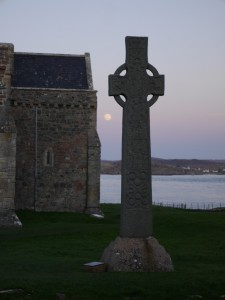While living and worshipping with other pilgrims at Iona during Holy Week, we were afforded the opportunity of meeting in small groups in order to “go deeper” in our experience. The small group of which I was part included Pat, Fred, Josie, Margaret, Bronwyn and myself. I came to Iona eager to find conversation partners who, like me, were searching for theological approaches to understanding the atonement (i.e. how what took place in Christ’s death and resurrection has made us “at one” with God again) that went beyond the substitutionary/satisfaction theory which has dominated Christian understanding for the past millennium. While that particular conversation has not occurred to the degree I had hoped, many other rich conversations and insights have been part of my experience here. One small group meeting in particular comes to mind.

- St. Martin’s High Cross predates the 15th century Abbey by 600 years. It has looked down on an ever-changing world for more than 1,200 years. Sculpted from a single stone, its west face has scenes from the Bible, while its east face is richly adorned with bosses and serpents–symbols of resurrection.
The topic, loosely speaking, was how our faith was manifested in and through our lives. The comments of Fred (a Mennonite from Belgium and frequent visitor to Iona) stuck a sympathetic chord. “We often talk about the importance of our faith having two feet on the ground,” he said, “but this community is one with two boots in the mud.” Two boots in the mud–is not this what every Christian community should seek to be about?
The second comment that evening was from Pat, a former resident member of the Iona Community staff and now disbursed member who contributed in various ways to the week–most notably via hymns she’d written that were featured during the Three Days. “There’s a lot of talk about Iona being a “thin place,” she said (a reference to this island’s long and deep history as a sacred place for nearly 1500 years; a place where, in the words of Iona Community founder George MacLeod, the boundary between heaven and earth is particularly thin). “I don’t know about all that,” Pat said, “but I am drawn to the idea of being a thin person; one in whom Christ’s presence is visible.”
A thin person. Pat’s insight captures the essence of much of what I had been reading and have now been experiencing during this pilgrimage journey. What Patrick, Columba, Brigit, Aiden, Cuthbert, Hild, and so many other Celtic saints share in common–one reason they were revered in their own day and continue to be even now–is that they were all “thin persons,” persons in whose lives and actions one could see Christ manifest. And Pat was bold enough to claim that this “thinness” is not the province of saints alone, but is a way of being in life and world that is open to each of us. This is a welcome counterpoint to the ultra-negative view of human nature which underlies substitutionary approaches to the atonement, and one I am finding terribly refreshing.
In the final worship service prior to our departure from Iona the Monday after Easter , we sang a hymn Pat had written for the occasion of her youngest daughter’s confirmation. Verses 1, 2, and 5 are found below.
Lord of Life and Resurrection, in a graveyard damp with dew, you bequeathed God’s plan and pattern to a weak and frightened few. And the message of their story still today remains the same: Lives surrendered to God’s purpose open up God’s kingdom’s reign. So I set my life before you—all its passion, joy and pain, Contradictions, strength and weakness—to receive your touch again. Breathe your Spirit through its textures, shape its patterns, mend its wrong; so my dying and my living may release your Kingdom’s song. Thus in journey and in action may I make your Presence real; All my loving and my thinking your true patterning reveal. May the life which here I offer make your Kingdom plain to see; Then what started in the graveyard will continue on through me.© Pat Bennett. All rights reserved.
